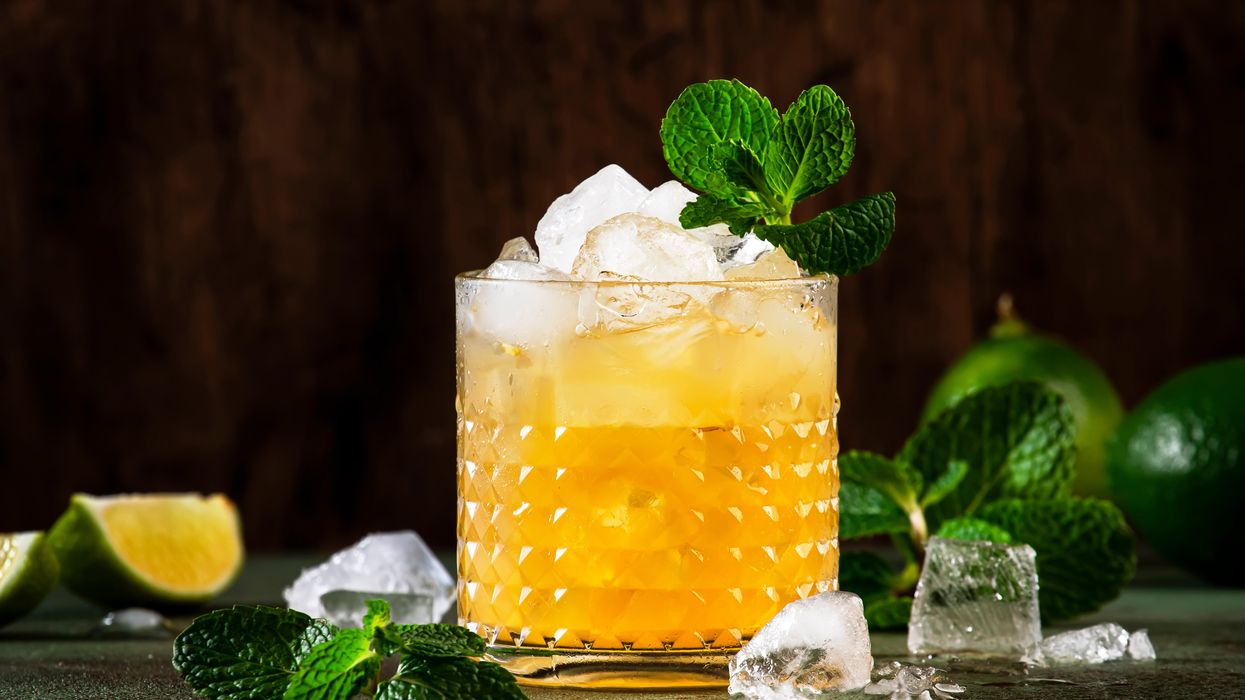
Adobe

The storied rum drink packs a Navy-strength punch; just don’t order it with an umbrella.
Let me tell you a story. It’s about a drink. Not just any drink, but a cocktail that once roared like an outboard motor on a moonlit Polynesian night. A drink that’s now been beaten, bastardized, and buried under a mountain of pre-mix and maraschino cherries by cruise ship bars and bad hotel chains. You know it. You’ve seen it. The neon-colored syrup slush that dares to call itself a Mai Tai.
But that’s not the real Mai Tai. That’s not the drink that shook the world in 1944.
The real Mai Tai was born in California. Not Tahiti. Not Hawaii. Not in some seaside tiki hut surrounded by girls in grass skirts and guys playing ukuleles. No, this concoction came into the world behind the bar at Trader Vic’s in Oakland, during wartime America. Victor Bergeron—Trader Vic himself—mixed up a stiff one for a couple friends visiting from Tahiti. When one of them took a sip and said, “Maita’i roa ae!” Tahitian for “out of this world, the best” he knew he had something.
That original recipe? It was a knockout punch: two ounces of rich, aged Jamaican rum (originally 17-year-old Wray & Nephew, unfortunately no longer made), fresh lime juice, orgeat syrup, orange curaçao, and a touch of rock candy syrup. That’s it. No pineapple juice. No grenadine. No goddamn coconut. Just strong rum, citrus, and a hit of almond—shaken and served over crushed ice with a mint sprig and half a lime shell. Simple. Elegant. Deadly.
It was a drink that didn’t ask for your approval. It demanded respect.
But like all good things in America, it got popular. Too popular. It followed the postwar boom, hitching a ride on the tiki craze that swallowed the country in the ‘50s and ‘60s. Suburbanites wanted an escape—something exotic, something that whispered of Bali Hai and palm trees and postcolonial fantasy. So bars started cutting corners. The original Jamaican rum ran out. Fresh lime gave way to sour mix. Orgeat became almond flavoring. Then the floodgates opened: pineapple juice, grenadine, cherries, umbrellas, whipped cream, whatever kitsch the bartender could grab from the back shelf.
By the time Elvis was making movies in Honolulu, the Mai Tai had gone full Vegas: sugary, bloated, and drunk on its own image.
Hawaii didn’t help either. Tourists flocked there and wanted that “island drink,” so the hotels gave them what they thought they wanted. And what they wanted, apparently, was a tropical trash fire. You’d get something pink and sweet and foamy, served in a coconut shell with a plastic monkey hanging off the side. It wasn’t a cocktail. It was a clown show in a glass.
And yet—the real Mai Tai survived. Barely.
It survived in dusty recipe books and in the hearts of a few die-hard bartenders who remembered the old ways. Guys in Hawaiian shirts with sleeve tattoos and serious rum collections. Tiki nerds. Cocktail archaeologists. They dug up the past, unearthed the bones, and brought the original Mai Tai back to life. These days, you can find the real thing in good bars in L.A., New York, London, Tokyo. If you’re lucky. But it’s straightforward enough to be made at home, and, if you have the inclination, it’s very rewarding.
And when you do—when you taste that perfect balance of funky Jamaican rum, fresh lime, and nutty orgeat—you understand what the fuss was all about. It’s not just a drink. It’s a story of postwar America, of boom and bust, ruin and revival. It’s a cautionary tale of how we ruin beautiful things, and sometimes—just sometimes—we get them back.
So next time you order a Mai Tai, ask what’s in it. If the bartender says “pineapple,” walk away. If you see grenadine or tiny umbrellas make an appearance, make a run for it.
You deserve better than SpongeBob in a glass.
The original 1944 recipe—no pineapple, no grenadine, just pure tropical elegance.
2 oz aged Jamaican rum (e.g., Appleton Estate 12 Year)
0.75 oz fresh lime juice (about half a lime)
0.5 oz orange curaçao (e.g., Pierre Ferrand Dry Curaçao)
0.25 oz orgeat syrup (almond-based; use a high-quality one like Small Hand Foods or Liber & Co.)
0.25 oz simple syrup (1:1 sugar and water)
Garnish: spent lime shell & fresh mint sprig
Shake all ingredients with ice until chilled.
Strain into a rocks glass filled with crushed ice.
Garnish with the lime shell (upside down—it floats like an island) and a mint sprig (tiki tradition—smack it to release the aroma).
Want a richer flavor? Use a blend of 1 oz Jamaican rum and 1 oz Martinique rhum agricole.
Never add pineapple or orange juice—those are later, touristy riffs.
The mint and lime shell aren’t just decoration—they add essential aromatics.
Peter Gietl is the managing editor of Frontier and Return. He lives in Texas.